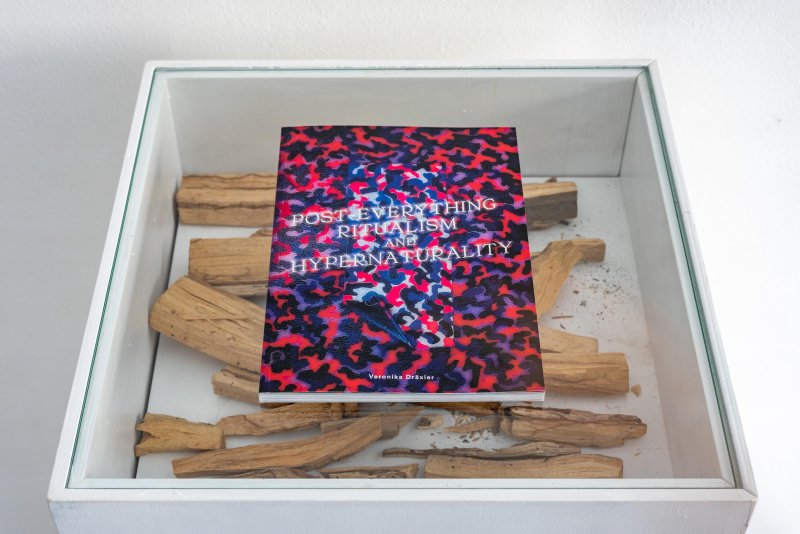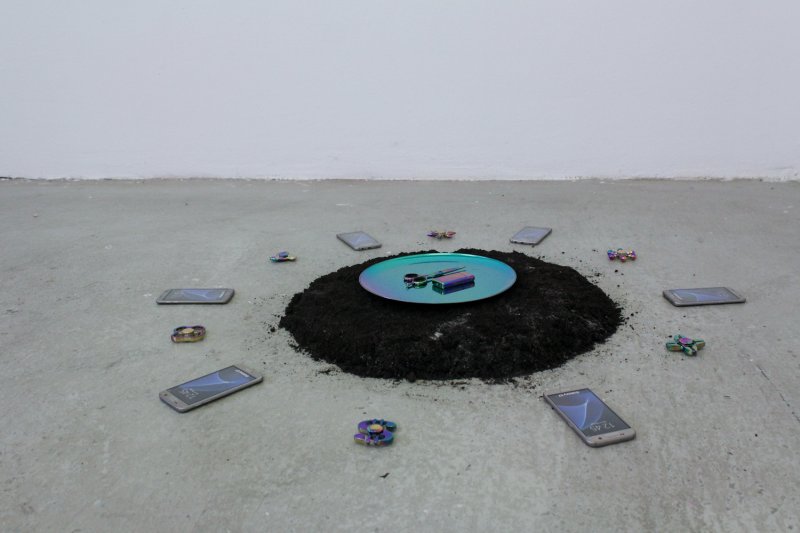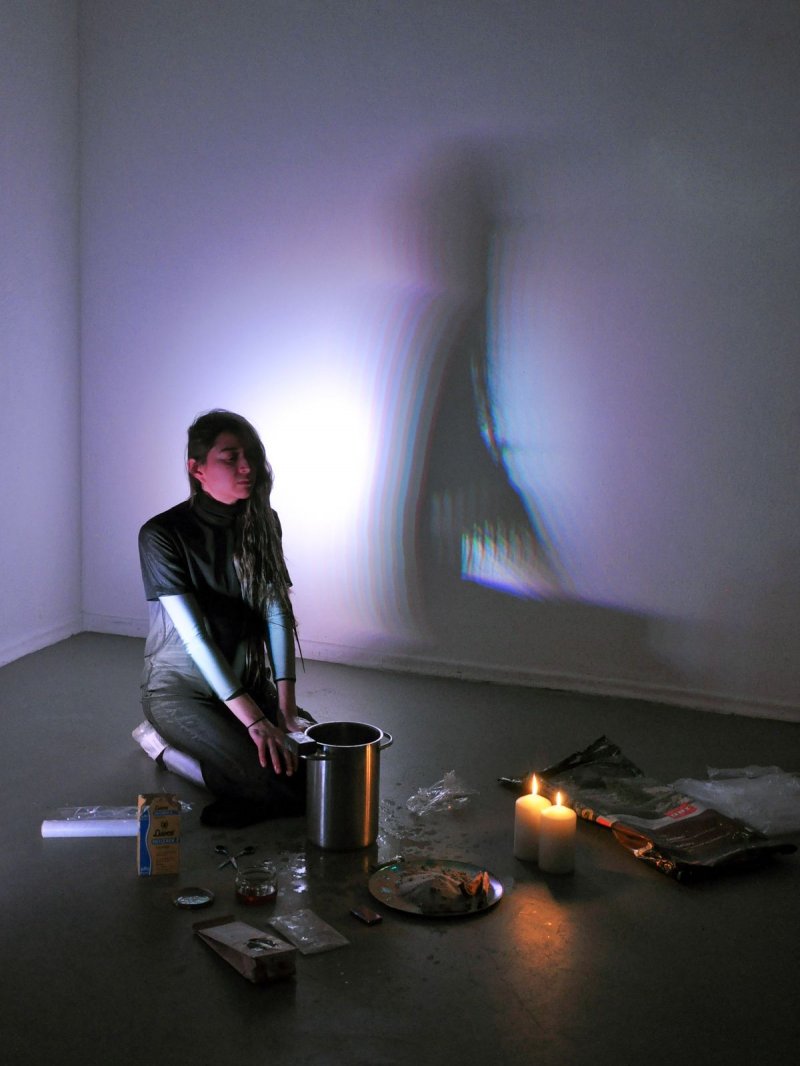Veronika C. Dräxler: Renewing Self. The ritual principles
Is entering an art exhibition or watching a performance sometimes similar to stepping into a church?

Is entering an art exhibition or watching a performance sometimes similar to stepping into a church? All these are somehow ritualistic moments: whether as participant or spectator, one could be said to experience a “sequence of activities involving gestures, words and objects, designed to influence preternatural entities or forces on behalf of the actors” . While one aspect of the art world reflects steely rationalism, artists in the early ‘70s have begun to challenge this state through performance Art. Developing their own form of spirituality through this medium, using a combination of cultural symbols, personal fetishes, and mystical experiences.
In her recent performance Renewing Self, Veronika Draexler deploys a combination of
objects and actions meanwhile using the exhibition space literally and figuratively as space for reconnecting with the earth, and re-imagining our relationship with the omnipresent technological apparatus. From this perspective, we can see Draexler’s performances as rooted in biographical events reflecting a combination of intense religious experience, conscious dependence on technology, and her diversity of origin, a mixture of European and Latin-American culture. Taken as a composite whole, the performance emerges from a process that can both express a human need for ritual and foreground the hybridity of our culture, reflecting not only the multiplicity of the artist’s origins, but also the impact of the interconnection between technology and the body, and the necessity of ritual in order to reground, to escape a certain reality imposed by a standardized market.

Draexler’s performance follows a somewhat ritualistic protocol, a series of well-defined
actions that she carries out in front of the public: lighting candles with a Tesla-brand lighter, pouring sand onto a bowl, placing palo santo in it, cutting off twelve centimetres of her hair. Burning it, merging and burying the remains, placing fidget spinners next to smartphone dummies, spinning them, and finally watching them slow down until they stop. If these steps were written out as a list, those actions could recall other conceptual performances of the 1970s in which instructions were written down for the viewer, as in Bruce Nauman’s “Body Pressure”. But Draexler’s process is, in fact, of a more personal nature. She shares a moment of intimacy with the spectators in which each individual task could be linked to private customs, traditional spiritual practices, and cultural symbols.
There is, of course, no such thing as a culture that exists in itself autonomously, with no interconnection with other cultures. Likewise, the tasks performed by Draexler, their origins and interpretations, are not bound by one particular culture. Every single gesture becomes the locus of a complicated and convoluted series of cultural references. Take for instance the act of lighting candles. It could be easily read as a Christian ritual although the gestures’ origins stretch back to Jewish and pagan traditions. Draexler’s performative experience thus accentuates syncretism by inventing and mixing in new ceremonial actions.
Palo Santo (“holy stick”) is a type of wood taken from a tree native of the Latin
American region, where it is traditionally burned in rituals of purification. By combining this with the lighting of candles, Draexler symbolically connects two worlds, metonymically telling a story of conquest and colonization. More than connecting to her own biographical roots, this provocative juxtaposition elicits the cultural hybridity violently caused by the arrival of the Spanish on the continent they were soon to claim their possession. Alongside appalling violence and relentless economic exploitation, the evangelization of the native population led to innovative and fertile examples of cultural and ritual syncretism. And some of these can be read as astonishing performances, not entirely unlike something we might expect or hope to come across in an art context.

San Juan Chamula, a village in the highlands of Chiapas, Mexico. Step into the five-hundred-year-old church in the central plaza. Inside, instead of pews, the floor is strewn with hay, tealights, wax and pine needles. Chickens scuttle around, enjoying a brief reprieve before they are sacrificed at the foot of the main altar. Believers, adults and children, drink coca-cola and pray in front of small terracotta statues of saints. Tourists gawp voyeuristically. Strange as it may sound, the coca-cola is more integral to the ritual than the poor chickens. Adherents young and old drink huge volumes of the liquid and belch mightily, the idea being that by so doing they are expelling malign spirits from their bodies. The dark, musty space of the church reverberates with the sound of unabashed, communal burping.
In this way, despite being officially Roman Catholic, the people of San Juan Chamula
integrate elements of pre-Hispanic beliefs and rituals into their religious practices. The coca-cola bottles become a symbol and a site of this syncretism: an ancestral mysticism, couched in the language of orthodox christianity, and accentuated through a recourse to the icon par excellence of globalisation and Western modernity. One reading of the people of San Juan Chamula’s appropriation of coca-cola would posit it simply as evidence of the inevitable hegemony of transnational corporations, invading and corrupting local traditions. But there is more to it than that. The bottle and the liquid are simply elements of a relentless syncretic approach, no more incongruous or contradictory than any other aspect of this lived and ever-evolving tradition. More than the passive victims of the onslaught of globalisation, these people have creatively integrated elements of a contemporary reality into their ancestral patterns, demonstrating how a vibrant, self-assured culture can incorporate foreign elements as a way of strengthening and actualizing its core values.
In this sense, the example of San Juan Chamula alongside other Central and Latin
American ritual practices can furnish us with a way to approach Draexler’s work. Her
integration of contemporary elements such as a Tesla-brand lighter and the smartphone dummies into a ritual constitutes a reflection on the impact of technology on our personal state of minds, but also shows how these alien, apparently soulless objects might have penetrated our lives to the point that they have become more part of the human life than any sacred objects. Through their symbolic integration as derived products and replicas, Draexler suggests a possibility of distanciation, of re-invention and a new hybridization of rituals: she offers an escape from this technology, or so to speak, a suspension in time. Isn't this finally the true “use and value” of rituals?
This text has been published in the Catalogue-Magazine by Veronika Dräxler on the occasion of her exhibition "Post-Everything Ritualism & Hypernaturality at Galerie GEDOKmuc, Munich, October 16th - 30th, 2019
The Catalogue-Magazine can be ordered via E-Mail at Hammann von Mier Verlag Hammann von Mier Verlag